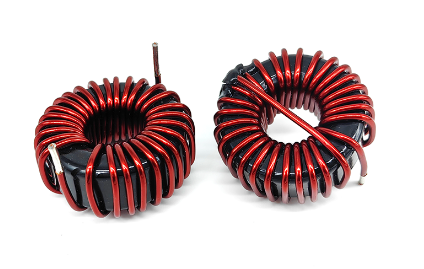The Working Principle and Structure of Toroidal Inductors
Working Principle: The working principle of a toroidal inductor is based on electromagnetic induction. When an electrical current flows through a wire wound around a toroidal core, a magnetic field is generated. This magnetic field stores energy in the form of magnetic flux. The magnetic flux, in turn, induces a voltage in the wire when the current changes, according to Faraday's Law of Electromagnetic Induction.

Structure: The structure of a toroidal inductor consists of three primary components: the toroidal core, the wire winding, and the terminals.
Toroidal Core: The toroidal core is the central component of the inductor. It is typically made of a ferromagnetic material such as iron, ferrite, or powdered iron. The toroidal shape ensures that the magnetic field remains concentrated within the core, minimizing energy loss due to radiation and leakage.
Wire Winding: The wire winding is wrapped around the toroidal core. It is made of a conducting material, usually copper or aluminum. The number of turns in the winding and the wire's gauge determine the inductance value of the toroidal inductor. The wire is carefully wound around the core to ensure uniform distribution and prevent overlapping or crossing of winding turns.
Terminals: The terminals of the toroidal inductor are the connection points for external circuitry. These terminals allow the inductor to be connected in series or parallel with other components within the electronic circuit. The terminals are typically soldered to the ends of the wire winding.
Significance: The design and structure of toroidal inductors offer several advantages and make them ideal for various applications:
Compact Size: The toroidal shape and efficient use of core material allow for a compact size, making them suitable for space-constrained electronic devices.
High Inductance: The toroidal structure provides a large surface area for the wire winding, enabling higher inductance values compared to other types of inductors.
Low Magnetic Interference: The closed-loop structure of toroidal inductors minimizes electromagnetic radiation and magnetic field leakage, reducing interference with nearby components.
Low Resistance: The short wire length and absence of overlapping turns result in low resistance, facilitating efficient energy transfer and reducing power losses.
Enhanced Efficiency: The concentrated magnetic field within the toroidal core ensures better energy storage and transfer, leading to improved overall circuit efficiency.
Conclusion: Toroidal inductors play a critical role in electronic circuits, thanks to their unique working principle and structure. By efficiently storing and transferring energy, toroidal inductors enable optimal performance in various applications. Their compact size, high inductance values, low magnetic interference, low resistance, and enhanced efficiency make them indispensable components in power supplies, audio systems, RF circuits, and numerous other electronic devices.




